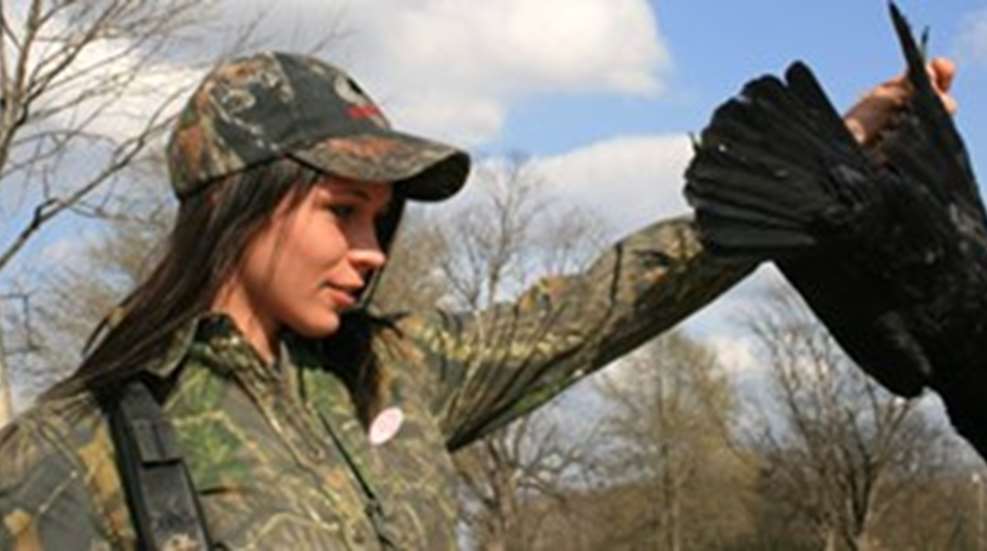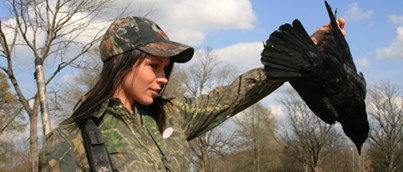
 The dark ominous shadows slide across the ground in front of you, and as you look up, a large dark bird glides by overhead. You swing the shotgun, tug the trigger and a dark blob tumbles from the sky as a small cloud of feathers gently floats down. There's no time to relax, however, because many wildly cawing crows have started swarming your location. It's reminiscent of the flying monkeys in The Wizard of Oz...they just keep pouring from the sky. When you properly prepare and hunt, crow hunting is a very fast-paced and sometimes technical adventure with many shooting opportunities.
The dark ominous shadows slide across the ground in front of you, and as you look up, a large dark bird glides by overhead. You swing the shotgun, tug the trigger and a dark blob tumbles from the sky as a small cloud of feathers gently floats down. There's no time to relax, however, because many wildly cawing crows have started swarming your location. It's reminiscent of the flying monkeys in The Wizard of Oz...they just keep pouring from the sky. When you properly prepare and hunt, crow hunting is a very fast-paced and sometimes technical adventure with many shooting opportunities.
The top reason to take on crows is because of the widespread damage those birds inflict on farm crops, apples and fruits, and other cash crops of landowners from coast to coast. Next, crows excel at raiding the nests of smaller songbirds and wild turkeys, destroying and eating eggs. Plus, hunting crows can help any hunter become a better wingshooter in preparation for hunting doves, ducks or upland birds. Pursuing crows teaches lessons in scouting, camouflage, calling, strategy development and oftentimes skills in landowner relations. Crows can also be used to train bird hunting dogs. Finally, crow hunting gives you the opportunity to match wits with one of the most intelligent bird species out there. So gear up, and go get ‘em!
Guns and Gear
Before your fire the first shot, take note that crows are very durable. When wingshooting, consider No. 6 shot as the minimum size. Crow feathers are like flexible plates of armor, plus these birds are bigger than pigeons. Use the larger sizes of shot to bring them down-and keep them down. Lighter shot-like the standard 7 ½-just won't effectively and consistently drop them.
One other route to toppling a crow is the long-range rifle-where it's one shot at some unsuspecting stationary crow. The .22-250 Rem., .223 Rem. and .204 Ruger rounds will work well for this. Use small bullets that fragment on impact, and plan on big magnification scopes (10X, 12X or higher power) atop a precision bolt-action rifle. If you plan to lie prone and make a long-distance shot, consider equipping that rifle with a bipod to keep it up off the ground and improve stability. The only downside to rifle shooting crows is that you almost always take only one shot, and then must move (ie. drive) to another distant hunting area because the crows in the area of the shot simply don't wait for a second shot-ever.
The Great Cover-Up
To properly prepare to go after a murder (yes, that's the name for a group of crows!), you should camouflage everything, especially your hands and head, including your face. Your face is where natural skin oils gather and these can reflect light and shine-and alert crows. You need to fully blend into your background and avoid the keen eyes of the many crows that circle overhead. You can also use shadows in your concealment strategies, but do select an area where you can look up and that's open enough so you can take shots directly overhead. Be certain also to cover up all hunting gear, such as callers and shell bags. Like turkeys, crows have excellent color vision, so conceal small items (like a colorful shotshell box) that can tip a crow to the fact that something is amiss. A quick method to accomplish this is to use tree branches, weeds, grass and other surrounding vegetation to cover gear-much as you would on a goose or duck hunt.
Calling all Crows
When calling and shotgunning those winged pests, plan to make the crows hunt you. There are two methods to make crows come to you-hand-held mouth blown tubes calls and push-button electronic calls. The good news is that electronic callers permit you to move, look up and actively hunt by simply pushing a button. An electronic call, however, will lighten your wallet by $100 or more. A mouth-blown call will cost about $10.
When selecting a call and calling method, note that the more loud ruckus and racket you can make, the more likely that crows will come to investigate or join in. Crows love a fight and are boisterous when they gang up on hawks and owls, especially when one of those birds has latched onto a crow.
It's also import to note that on crisp fall mornings, small sounds travel far. Be quiet when closing truck or car doors (no slamming), keep talk to a minimum with your hunting companions, and be prepared to shoot before you emit that first crow call. A crow could be lurking nearby and watching you.
That Deceptive Decoy
The number one thing that will put a crow in front of your shotgun is another crow. Several outlets offer crow-sized lifelike decoys that can be placed on the ground or secured to tree limbs. You can use those decoys to simulate a scene that no crow can resist-a fight. This tactic requires using a life-sized hawk or owl decoy placed on the ground with a crow decoy placed up under it. Take up a position nearby where you can easily swing your shotgun to shoot any crows that drop and dive onto this set up. It's very deadly.
The great news about hunting crows is that few if any states have any bag limits. To hunt in most states, however, you will need a small-game license. Due to migratory-bird treaties with other countries, crows now have hunting seasons on them, so check the regulations in the state where you will hunt.
One other note on crows: Try to find farms and land near cities for hunting sites, because those cities can be crow havens. In Watertown, N.Y., for example, as many as 30,000 crows roost in the city on winter nights. The city council there spent more than $4,000 for a wildlife management company to fend off the crows. Des Moines, Iowa also has a similar crow problem that requires city street crews to hose down buildings, sidewalks and streets after crows come to roost at night. In addition to white-washing areas with droppings, those city crows raid dumpsters, rip open garbage bags and cause mass mayhem as they hang out in the warmer, predator-free cities. Large murders can be intercepted as they fly out to farm fields to feed each day.
Crows-one of the best wingshooting opportunities in the skies overhead. Go get ‘em!
Gear to Go:
This gear can help you find success:
Semi-auto or double-barrel shotgun, preferably camouflaged
Call (hand-held or electronic)
Camouflage clothing: including gloves, face mask, and cap with brim
Crow decoys and an owl or hawk decoy to incite an attack
Decoy bag or camo daypack for moving gear
No. 6 or larger shotshells
Camouflage netting or shears to cut vegetation to aid with camouflaging
Camouflage campstool to sit on
Trash bag to hold the dead crows






































